

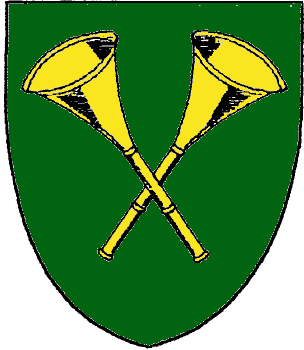
Crux Australis Herald
Lord Uberto Renaldi [mka Nigel Castle]
GPO Box 2719, Adelaide SA 5001, Australia
phone: (08) 8336 6791 or intl +618 8336 6791
 |
Crux Australis Herald Lord Uberto Renaldi [mka Nigel Castle] GPO Box 2719, Adelaide SA 5001, Australia phone: (08) 8336 6791 or intl +618 8336 6791 |
"The CAMeL"
December 1999 (A.S. XXXIV)
Unto the College of Heralds of the Principality of Lochac, and all others who may read this missive, from Lord Uberto Renaldi, Crux Australis Herald, greetings!
In this issue…..
Reports | A change to the RfS | Proposed changes to the RfS | Roster changes
Important addresses | Subscriptions and Resources | Submission requirements
Meeting schedule | Recent submissions | Returns | News of previous submissions
Season's Greetings!
Welcome to my third Camel. As you can see from the size of this issue, December has been a very busy month – 20 items from 11 submittors. On top of that there has been an End-of-Reign report to produce, several roster changes, preparations for Twelfth Night, and the build up to the festive season. I certainly can't complain of boredom!
Please accept my best wishes for a happy and prosperous New Year, and that you find an appropriate way to say goodbye to the `90s and herald in [pun intended] the final year of the second Millennium (yes, I'm one of those pedants who insist that the third Millennium does not start until 2001!)
For those who are going to Twelfth Night Investiture – see you there!
Your servant,
Uberto Renaldi
I did not receive an End-of Reign report from the following groups: Stormhold, Ynys Fawr, Borders Crossing, Mordenvale and Saint Florians-de-la-Riviere.
Thank you to those groups who did send reports in. I know Aislinn used to give a quick resumÈ of what's been happening in each group but, well, its been a busy month. Maybe next time...
A change to the Rules for Submissions
The following is from Laurel's Covering Letter to the October Letter of Acceptances and Returns.
[T]he rule XI.1 is amended to the following:
XI.1. Reserved Charges - Armory that contains elements reserved to or required of certain ranks, positions, or territorial entities, inside or outside the Society, is considered presumptuous. Symbols reserved or required solely inside the Society may only be registered to those entitled to the status associated with those symbols.
Examples of such elements include the field Azure, semy-de-lys Or, which is restricted to French royalty; a laurel wreath, required for official Society branches; the knight's annulet of chain, etc. Lists of these charges can be found in the glossary. Some elements, like the French royal field, are always restricted. Others are limited to specific segments of the Society. For example, individuals may not place laurel wreaths on their armory, while only those who are royal peers may use the insignia of those ranks.
The change corrects the omission of the tincture of the fleurs-de-lys in the arms of France, and removes examples that are either problematic or overturned. The rule itself is unchanged.
Proposed changes to the Rules for Submissions
In a letter to the College of Arms dated 25 September, Palimpsest Herald (Laurel's deputy for rules changes) put forward three proposed changes to the Rules for Submissions for comment. I will not duplicate the six-page letter here, just give a brief summary.
This proposal is to replace the somewhat restrictive definition of Arms of Pretense (rule XI.4) such that only a single charged and/or multi-tinctured escutcheon (a small shield shape) placed in the centre of the field will be considered Arms of Pretense and therefore presumptuous. A single uncharged escutcheon of a single tincture, multiple escutcheons or charged/multi-tinctured shapes other than escutcheons (eg roundels and lozenges) will all no longer be considered Arms of Pretense and will therefore not presumptuous.
It is proposed to add two new sections to the Rules (VIII.7 and XI.5) to make the written rules consistent with practice. The first deals with the style of augmentations, and in what ways some rules may be overlooked when registering armoury using them. The latter states that using something that looks like an augmentation (a charged or multi-tinctured canton or escutcheon) is considered presumptuous unless the submittor has been granted the right to use it.
This proposal, if it gets approved, will make our lives much easier! First, it rewrites the definition of what constitutes “simple armoury” and pares it down to “armoury which has no more than two types of charge directly on the field or overall”. Secondly, only the submitted armoury has to be “simple armoury” for the Difference of Primary Charges rule to be applicable in conflict-checking (currently both the submitted and protected armoury have to be “simple” if you want to use this rule to show they do not conflict). This will make conflict-checking quicker, and make a lot more simple armoury registrable.
If you want to know more, contact me or go to Laurel's web site where the letter can be downloaded from the LoAR archive. Commentary closes on 31 January 2000, so if you do want to comment you will need to get something to me ASAP!
In Rowany, Robert Gordon of Ravensbrook (lately of Innilgard) will shortly be taking over the office of Cinquefoil Pursuivant from Catarina del Vino.
In Politarchopolis, Sigmund Spelmann has, after many years of service, handed the office of Cordon Rouge Pursuivant over to Snorri BlÛdhdrekkr Ûr ²dhinsslundi.
Elswyth of Bery has resigned as PE for Dismal Fogs in order to become the Shire's seneschal. A replacement is being organised.
Finally, the Shire of Saint Florians-de-la-Riviere has a new PE: Sabine de Bourbonnais, who replaces Catrin of Kilkenny.
“The CAMeL” is available from Crux Australis at $20 per year. Make cheques payable to "SCA Inc. College of Heralds". Alternatively, get it for free from “http://www.sca.org.au/herald”.
Laurel's Letter of Acceptance and Return is available from the SCA College of Arms. Send a cheque for $US25 made out to “SCA Inc. – College of Arms” to Bruce R. Nevins, 2527 E. 3rd Street, Tucson AZ, 85716-4114, USA. As usual, everything of relevance to Lochac will be published in “The CAMeL”.
Master Thorfinn is the person to talk to about heraldic publications. Possibly the most useful item that he stocks is the Heraldic Pictorial Dictionary for the SCA (affectionately known as the PicDic), which will cost you $A8.50 for the first edition or $A12.50 for the second edition. Alternatively, order it directly from the USA via Free Trumpet Press for $US15 (details of their web site are below – and they now take credit cards).
I also recommend that groups acquire some name resources, in particular P.H. Reaney & R.M. Wilson's A Dictionary of English Surnames and E.G. Withycombe's The Oxford Dictionary of English Christian Names.
Thanks to Jan of Ghent for giving the Crux Australis web page at http://www.sca.org.au/herald a facelift.. It now contains the submission and Court Herald's Award forms in PDF format, as well as the usual stuff: back issues of Camels, current Lochac heraldic policies, and links to the SCA Heraldry page as well as other general SCA pages.
Many interesting heraldic links can be found through the SCA Heraldry web page at http://www.sca.org/heraldry including the Laurel home page, on-line armorial and ordinary search, and the Academy of St. Gabriel (an heraldic consultation service). The Free Trumpet Press West web page is http://www.sca.org/heraldry/ftpw or email klconlin@ilstu.edu
Cost: $20 per new submission (name, device or badge). No cost for resubmissions or branch submissions. Make cheques payable to "SCA Inc College of Heralds".
Copies required for submissions:
THIS IS REALLY, REALLY IMPORTANT!!!
Please check that submittors have ALL necessary documentation to support each submission. It is up to the submittor to present their submission in a way that makes registration easy. Name documentation should be as accurate as possible, and photocopies supplied unless the reference is a standard one such as Reaney or Withycombe. Even then, the page number(s) and edition should be quoted.
I don't like returning submissions, especially when it is obvious that a lot of work has gone into them. But if it not the right sort of work then everyone's time is wasted. If you cannot find documentation for a name I would much prefer if you contacted me asking for help rather than sending off a submission and hoping that I can fix up the documentation. If my books contain nothing then I may be able to contact someone else who can help.
It must be explained to submittors that the College of Arms has high standards for documentation – as high as any good A&S competition – but that there are plenty of heralds with a lot of knowledge willing to help. Their assistance is only gained via the submission process if they have something concrete to work with, but there are many who are also happy to offer their expertise if contacted informally.
Crux Australis Herald holds a meeting at least once a month to consider submissions, which are then either forwarded to the College of Arms for commentary (and hopefully registration), or returned (if we find a conflict or a stylistic problem) or, occasionally, pended awaiting clarification from the submittor. If we have the time and enthusiasm, we may also look at and comment on submissions from other Kingdoms.
Crux meetings are usually held at 36 Rosella Street, Payneham SA, starting at 2pm. Please call (08) 8336 6791 or Email me beforehand if you intend to bring submissions for processing. The next meetings are scheduled for Sunday 23 January 2000 and Sunday 27 February 2000.
Thorfinn Hrolfsson, Hund Herald, also holds regular commentary meetings in Melbourne. Please call him for details on (03) 9885 6348.
Present at the Crux Australis meeting held on Sunday 19th December 1999 was Lord Uberto Renaldi, Crux Australis Herald, and cornets Lord Alcuin Adelhard and Lady Katherine Parry.
The following items were SUBMITTED to Laurel Queen of Arms for registering:
1. Amalia van Bergen op Zoom
New Name (See RETURNS for Device)
Group: Saint Florian-de-la-Riviere
Consulting herald: Cornelius von Becke and Sabine de Bourbonnais
The submittor will not accept major changes, and has not indicated that they desire anything other than a female name, presumably Dutch or German from the documentation supplied..
According to Jobes (pp.82-83), “Amelia” is a feminine name from Old Teutonic whilst Van Der Schaar (p.29) lists “Amalia” as the name of a legendary person from the 8th century. Not very conclusive but it will have to do. “Bergen op Zoom”, according to The Illustrated Columbia Encyclopedia (vol 3, p.693), is a town in SW Netherlands which contains a 14th century town hall and a 15th century church.
2.Arrowreach, Canton of 
New Branch Name and Branch Device
Group: Stormhold
Consulting herald: Fergus an Feumail (Name) and Drogo von K–nigsberg (Device)
Per fess indented of three points, in pale a laurel wreath Or and two arrows crossed in saltire gules.
Originally submitted as Arrowsreach. this is a compound name, formed of the elements "Arrow" and "Reach".
"Arrow" is given by both Mills (p.12) and Ekwall (p.13) as a river running through Herefordshire and Warwickshire, dated at 1246 [Aruwe] and 1256 [Arewe]. It is also given as a village on that river in 1086 [Arue or Arve].
"Reach" has, as one of its many meanings cited in the OED (p.1517), "That portion of river, channel or lake which lies between to bends; as much as can be seen in one view", with a first documented usage of 1536. Other meanings include "a bay" (dated to 1526) and "a headland or promontory" (1562). Similarly, Hoad (p.390) gives as one of its meanings "continuous stretch, as of a waterway (in place-names), dated to the 13th century. Both Mills (p.270) and Eckwall (p.382) mention two places called "Reach" [Reche], one in Bedfordshire mentioned in 1276 and one in Cambridgeshire, from the Domesday Book (1086). Mills gives the derivation of the name as "(place at) the raised strip of land or other linear feature".
Although no actual names from the Society's period could be found that combined the elements "River-name" and "reach", according to Ekwall other medieval English towns had names formed in a similar fashion (ie river-name + geographical feature), such as Charmouth [Cernemue, 1212] (p.95) and Stourmouth [Sturmutha, 1089] (p449), meaning "mouth of River Char" and "mouth of River Stour" respectively; and Lydlinch [Lidelinch, 1285] (p.308) meaning "Hill on River Lidden".
"Arrowreach" could therefore mean "raised strip of land on the river Arrow", and seems acceptable as an invented English place-name.
The device, which was originally blazoned Per fess dancetty..., (only ordinaries are described thus) appears free of conflict, but the line of division could be drawn lower down and the wreath drawn larger.
4. Gwyneth ferch Aeddan
New Name
Group: Aneala
Consulting herald: Kane Greymane
The submittor would like a female Welsh name and will accept NO changes.
“Gwyneth” is one of the submittors legal given names, which is just as well as the documentation provided justifies its use only as a surname in our period. As several have been registered in the past few years I will assume that it is SCA acceptable. One “Aeddan ap Blegywryd” was, according to T.R. Davies, “killed in AD 1016” (p.35).
5. Humphrey de la Pole
New Name (see RETURNS for Device)
Group: Saint Florian-de-la-Riviere
Consulting herald: Cornelius von Becke and Sabine de Bourbonnais
The submittor desires a 14th – 15th century male name and cares most about the sound.
“Humphrey” was the name given to the youngest son of King Henry IV of England and who died in 1447 (Hanks and Hodges, p 159 and Cannon and Griffiths, p 203). Withycombe (pp 158-159) mentions that “the spelling with ph instead of f is relatively modern, but does not give any dates. A “Sir John de la Pole” died c1380 (Clayton, p 36), and any good book on late medieval England should mention the influential De La Poles who were Earls (later Dukes) of Suffolk.
6. Leofric Willoughby de Broke 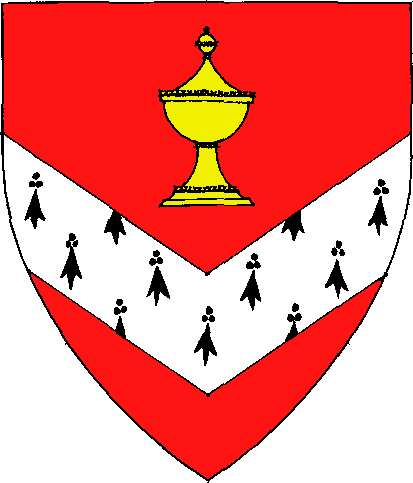
New Name and Device
Group: Saint Florian-de-la-Riviere
Consulting herald: Sabine de Bourbonnais
Gules, a lidded chalice Or and a chevron inverted ermine.
The submittor would like a male name and will accept only minor changes.
“Leofric” is given by Withycombe (p 193) as a common Old English name which survived the Norman Conquest. According to Reaney (p385) a “Thomas Willoughby” was alive before 1449, with the earliest version being borne by a “Robert de Wilgeby” who lived 1175-1184. The Mormon Church records supplied are not acceptable on their own as documentation, but do list a Willoughby genealogy which includes a “Sir Robert Willoughby, 1st Lord Willoughby de Broke” who died 23 August 1502 (his son died `of a pestilential air' in 1521) and traces the family back to a “Sir William Willoughby”, died 1306.
The device is technically clear of Gules, a chevron inverted ermine, overall a snaffle bit chevronwise Or (device for Rosamund of Derby, 2/87) as there is one CD for adding or removing charges placed directly on the field (the chalice), and another for adding or removing charges placed overall (the snaffle bit). Although there is some visual similarity, those at the meeting did not consider it is not overwhelming.
7. Madeleine du Lac d'Agenais 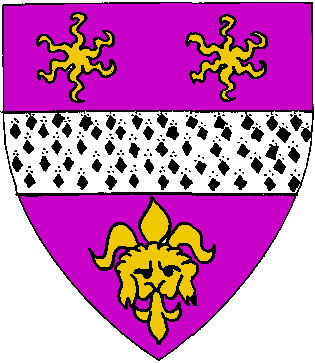
Name Resubmission and New Device
Group: Politarchopolis
Consulting herald: Sigmund Spelmann
Purpure, a fess ermine between two estoiles and a leopards head jessant-de-lys Or.
The submittor would like a female French name from the 14th-16th centuries, and cares most about the sound and language/culture. She will accept minor changes.
This name was returned in November by Crux for lack of documentation showing “Madeleine” as a name used in our Period. Further documentation has been provided but again it is not conclusive. Dauzat and Rostaing (p.422) have an entry for “Madelaine (La)”, referring to churches named in honour of Saint Marie-Madelaine, but all of the period spellings have a “g” and end in “aine” or “ene” rather than “eine”.
Fortunately, Withycombe (p.202) has come to the rescue! It's use as a given name, in England at least, started in the 13th century, and “...the French form of the name, Madeleine...” appears to have been in use prior to the 17th century. Hopefully someone in the College of Arms can verify that submittor's preferred spelling is period.
The rest of the name, meaning “of the lake in/of Agenais” is an acceptable invented byname – Agenais was an area of southern France in the time of Eleanor of Aquitaine (Kelly, no page number given).
The device appears free of conflict. The submittor will be advised to draw fewer and larger ermine spots, as the fess could almost pass for semy of lozenges sable the way it is drawn.
8. Morgan of Harlech
Resubmission of Name (See RETURNS for Device)
Group: Torlyon
Consulting herald: the submittor
The submittor would like a Welsh or Anglicised Welsh name of either gender, and will accept NO changes. This name was previously submitted and has been “held” by Crux since August 1998 awaiting confirmation that the submittor is happy to accept a name that can only be documented as male.
According to Withycombe (p 222), “Morgan” has been a favourite Welsh name from early times. The Encyclopedia Britannica, under its entry for “Mogannwg” (vol 8, pp 322-323) states `The region derives its Welsh and later English names from Gwlad Morgan, meaning “The Land of Morgan,” after a 10th-century Welsh prince.'
Other documentation supplied referred to the “Morgan le Fay” of Arthurian legend. Literary references are not proof that a name was used by real people in history, even if they are famous stories that are retold for generations. Imagine for instance if Star Wars was to become immensely popular and retold in various forms for the next 800 years – a 28th century person would be in serious error if they deduced from it that “Darth” or “Skywalker” were common elements of late 20th century English names! OK, its not the best analogy, but the point remains the same – documentation is needed to show that a name element was actually used by real people, and only references with dates or time-periods in them are really useful.
The locative “of Harlech” is acceptable, although no documentation was provided to show “Harlech” as a period place-name (Harlech Castle was built for Edward I between 1283 and 1290).
9. Salaberge de Granson
New Name (see RETURNS for Device)
Group: Saint Florian-de-la-Riviere
Consulting herald: Sabine de Bourbonnais
The submittor desires a female 14th-15th century French or German name and will accept NO changes.
According to the Academy of St. Gabriel, “Salaberge” originates from the Frankish name “Sallaberga”, and `it was common for the final “a” on older names to become and “e” over time.' The submittor also makes reference to Dauzat (p.536) but as I do not have a copy and no photocopy was supplied I am unable to verify the reliability of this source.
“Granson”, according to Muir (p.29-30) is a village on the shores of Lake Neuch’tel in Switzerland and was the site of a battle in 1476.
10. Wilfrid de Ackelonde 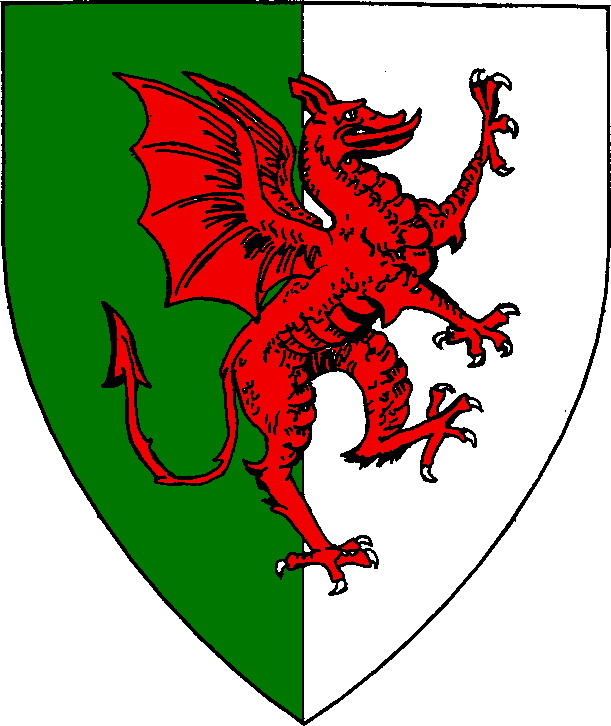
Device Resubmission to Laurel
Group: Parvus Portus
Consulting herald: the submittor
Per pale vert and argent, a dragon contourny gules.
The submittors last device, Checky sable and argent, a dragon rampant gules, was returned by Laurel in August 1999 for conflict, of which this new design appears free. There was much comment at the meeting on the similarity between this device and the arms of Wales (Per fess vert and argent, a dragon passant gules) even though it is possible to technically count two CDs between them – one for the field and another for the posture of the dragon. I will leave it up to the College of Arms to decide if this device is considered presumptuous.
William the Admirer
New Name (See RETURNS for Device)
Group: Saint Florian-de-la-Riviere
Consulting herald: Sabine de Bourbonnais
The submittor would like a male name and cares most about the sound.
A certain chap called William invaded England in 1066, from which time on it became one of the commonest men's names there (Withycombe, p.293). “the Admirer” is an SCA acceptable epithet.
The following items have been RETURNED for further work:
1. Amalia Van Bergen op Zoom 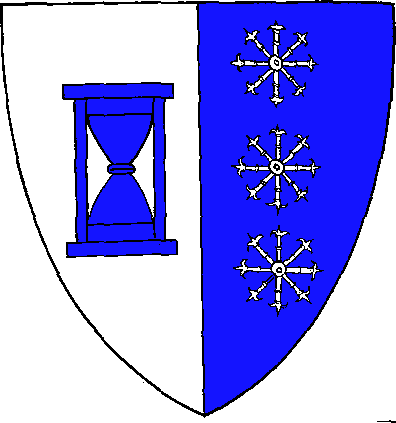
New Device
Per pale argent and azure, an hourglass and in pale threeescarbuncles counterchanged.
This is being returned for two reasons. First, it violates rule “XI.3 Marshalling”, in that it could easily be mistaken for impaled arms. Secondly, the azure was so dark on the form that everyone who saw it mistook it for sable. This was not a case of mis-blazoning as the submittor included a note for scribes requesting “navy blue not pale blue”.
2. Humphrey de la Pole 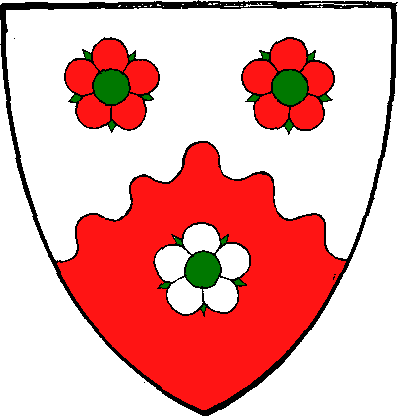
New Device
Per chevron wavy argent and gules, three kendal flowers counterchanged, barbed and seeded vert.
This device appears free of conflict, but is being returned for two reasons:
3. Morgan of Harlech 
Resubmission of Device
Per bend sinister argent and Or, a phoenix proper.
The submittor's previous submission was returned by Crux in August 1998. This complete redesign is a beautifully drawn and coloured device, but must sadly be returned for three reasons:
The basic design is a good one, however, and the submittor will be encouraged to resubmit using a less colourful phoenix, so long as they avoid azure or purpure, as these will conflict will existing armoury.
4. Sabine de Bourbonnais 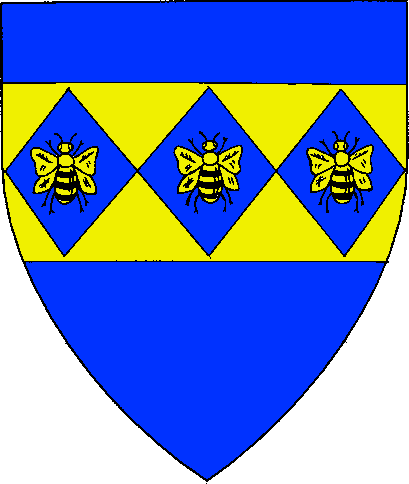
New Name and Device
Azure, on a fess Or three lozenges conjoined azure each charged with a bee volant Or.
The submittor desired a female 12th century French name and elected to accept NO changes.
Alas, because of this I must return it, as the documentation supplied does not justify this spelling. Dunkling and Gosling (p 247) and Withycombe (p 248 on the photocopy but p 260 in my edition) both cite “Sabina” as a Roman name, and the latter also gives the male name “Sabin” used in England from the 12th century. Although I imagine the French form to have been “Sabine”, having no books on French given names I cannot confirm this. If the submittor had elected for minor changes to be made I would have been able to send it on to Laurel as “Sabina” and someone in the College of Arms may have found support for the original spelling.
The eye-catching device must be returned for contravening VIII.1.c.ii of the Rules for Submissions: Layer Limit. "All charges should be placed either directly on the field or entirely on other charges that lie on the field." Each of the bees are a charge on a charge on a charge, and that's not allowed. I could not justify reblazoning the device Or, a fess of three fusils azure, each charged with a bee volant Or, between a chief and a base azure as the chief would then be too small, the base too large and the fess fusily should not be so close to the chief and base. However, this can be fixed with a redraw.
Salaberge de Granson 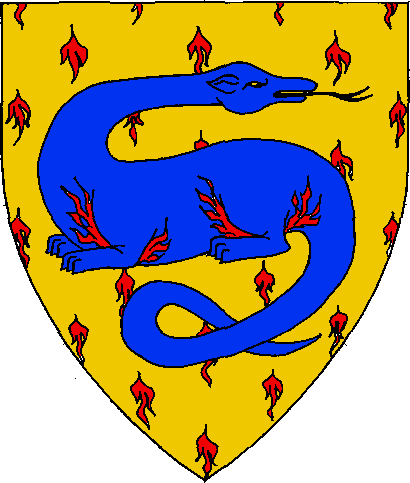
New Device
Or semy of flames inverted gules, a salamander couchant reguardant azure enflamed gules.
This has been returned for redrawing. This depiction of a salamander did not resemble any in the heraldry books inthe Crux library. Those showed the heraldic salamander as being more lizard-like and with lots more enflaming. What was submitted could not be identified as anything other than “a dinosaur-type thing.” Another comment made was that the semy of flames inverted are also hard to identify and could well be mistaken for ermine spots [which would be better heraldically anyway].
William the Admirer 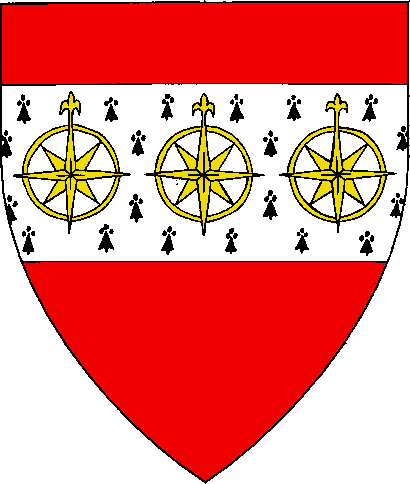
New Device
Gules, on a fess ermine three compass roses Or.
This is being returned for violation of rule VIII.2.b Contrast Requirements: “ii. A charge must have good contrast with any charge placed wholly on it.” In this case, the compass roses Or do not have good contrast with the fess ermine, as both Or and ermine are considered light-tinctured for the purpose of contrast. The submittor will be advised to make the compass roses another colour [I suggest gules] and to draw the fess a little lower on the shield.
References
**Note** OUP = Oxford University Press.
Cannon, J. and Griffiths, R., `The Oxford Illustrated History of the British Monarchy', OUP, 1988.
Clayton, Muriel, `Victoria and Albert Museum Catalogue of Rubbings of Brasses and Incised Slabs', Her Majesty's Stationery Office, London, 1968.
Dauzat, A., `Le Noms de famille et prenoms de France'
Dauzat, A. et Rostaing, Ch., `Dictionnaire Ètymologique des noms de lieux en France', Libraire Larousse.
Davies, T.R., `A Book of Welsh Names', Sheppard Press, London.
Dunkling, L. and Gosling, W., `Everyman's Dictionary of First Names'
Eckwall, E., `The Concise Oxford Dictionary of English Place Names', 4th edition., OUP, 1991.
`Encyclopedia Britannica', 15th edition, 1993.
Hanks, P. and Hodges, F., A Dictionary of First Names', OUP.
Hoad, T.F. (Ed), `The Concise Oxford Dictionary of Word Origins', BCA, 1992.
`The Illustrated Columbia Encyclopedia', 3rd edition, Columbia University Press, 1972.
Jobes, Gertrude, `Dictionary of Mythology, Folklore and Symbols', The Scarecrow Press, New York, 1962.
Kelly, Amy, `Eleanor of Aquitaine', Harvard University Press, 1959.
Mills, A.D., `A Dictionary of English Place Names', OUP, 1991.
Muir, Ramsay, `Muir's Atlas of Medieval and Modern History', George Philip and Son, Hong Kong, 1982.
`OED' = `The Compact Oxford English Dictionary', 2nd edition, OUP, 1991. (NB: this is the complete 20-volume 1989 edition reproduced micrographically in one volume. It comes with its own magnifying glass!)
Reaney, P.H. and Wilson, R.M., `A Dictionary of English Surnames', 3rd edition, Routledge London 1991.
Van Der Schaar, J., `woordenboek van voornamen', Het Spectrum, Utrecht, 1979
Withycombe, E.G., `The Oxford Dictionary of English Christian Names', 2nd edition, OUP, 1959.
No Lochac Letters of Intent were considered at Laurel's September or October meetings.